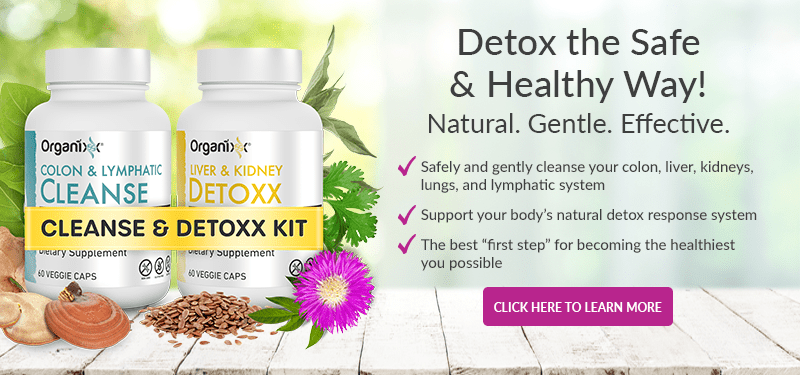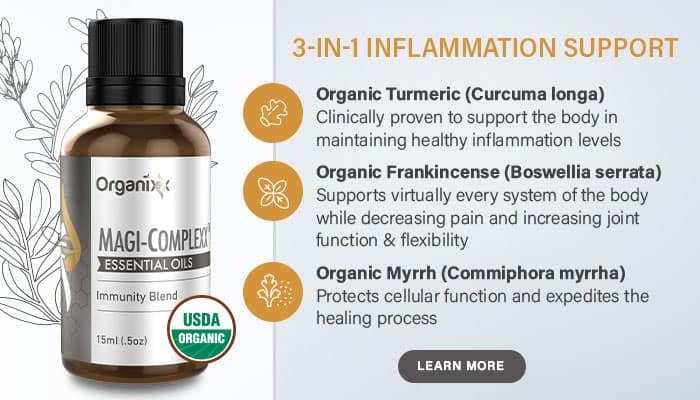It doesn’t matter how many supplements you take or how many pounds of green veggies you consume… if your digestive and other nutrient input mechanisms are off-balance, your body will not be able to take advantage of all the “good stuff” you’re putting into it. Nutrient malabsorption can lead to serious issues for an individual. It is also a foundational disease-causing problem that has reached epidemic proportions around the world.
3 Primary Ways Malabsorption Occurs
Maintaining health by providing the body with all that it needs is a delicate dance. As you can probably imagine, malabsorption adds another level of complication to an already intricate choreography that eventually ends in some form of malnutrition. More often than not, disease conditions occur due to malabsorption of nutrients over decades.
In a nutshell, malabsorption is a situation where, for whatever reason, the body cannot break down and absorb certain proteins, fats, vitamins, nutrients, minerals, and enzymes in foods (and subsequently in any supplements) that a person may be taking.
So, what causes malabsorption in the first place? The following are just a few possible reasons.
#1. Gut Imbalance
Ultimately all other malabsorption triggers (which we will get to in a minute) come down to what  happens in the gut. This is because the digestive tract is the “first stop” for a nutrient breakdown.
happens in the gut. This is because the digestive tract is the “first stop” for a nutrient breakdown.
According to the Merck Manual [1], digestion and absorption occur in three phases. First, bile salts help food break down in the intestinal tract. Secondly, certain enzymes begin to digest (i.e., break down), microscopic food particles even further into substances cells can absorb for nutrition. Lastly, the lymph fluid transports these nutrients where they need to go.
When phase one of this process goes awry, this is sometimes called maldigestion. When any part of the second or third phase of this process is hindered, this is technically called malabsorption.
Anything that contributes to an imbalance of gut flora can lend itself to malabsorption issues too. Typical stress and diet-related conditions can result in malabsorption. These include:
- irritable bowel syndrome (IBS)
- acid reflux
- diverticulitis [2]
- small intestinal bacterial overgrowth syndrome (SIBO) [3]
- leaky gut (intestinal permeability)
- gut dysbiosis (lack of diverse gut flora) [4]
Specific GI-related traumas such as radiation therapy for cancer, intestinal infection, lactose or gluten intolerance, parasite infestation, taking certain kinds of drugs such as tetracycline, colchicine, or cholestyramine, or taking too many antibiotics [5] can also contribute to this condition.
On the other hand, malabsorption of certain substances can result in some of the conditions mentioned above. For example, IBS can be caused by malabsorption of fructose in the GI tract [6].
#2. Methylation Issues
A little-known cause of nutrient malabsorption can malfunction in methylation. Methylation is the process by which chemical compounds are converted into other needed substances. For example, methylation helps convert serotonin into melatonin and aggressive estrogens into less aggressive ones.
Even though methylation is a fairly complicated chemical process, it is also a very ordinary one; it happens in your body every single day. And when it isn’t functioning properly, malabsorption of nutrients is one of the unfortunate results.
There are many reasons why an individual may have poor methylation. A big one is a particular genetic condition commonly referred to as the MTHFR gene mutation. The MTHFR gene impacts how well your body metabolizes the enzyme methylenetetrahydrofolate reductase or MTHFR. This may sound like a rather obscure term, but without it, the body cannot then metabolize many common substances.
Metabolization of protein and certain kinds of vitamins and minerals, including folate which is required for cell division, can be affected. The MTHFR gene mutation can also lead to other complications in digestion, hormone balancing, and immune function.

The MTHFR gene mutation may be more widespread than previously thought. It is estimated that between 30% and 60% of all individuals worldwide may carry the MTHFR gene mutation, which is passed down from parent to child [7].
Some individuals will have the mutation but not express any of its complicated symptoms. On the other hand, between 14% to 20% of the population may have a more severe form of it which can impact health more severely. You can find out if you have the MTHFR gene mutation through a simple genetic test.
#3. Specific Disease Conditions
Finally, there are some disease conditions that also have a malabsorption component, some of which are not necessarily related to the GI tract initially:
- Digestive diseases such as celiac disease, Crohn’s disease, tropical sprue, or whipple disease
- Cystic fibrosis
- Diseases of the liver, such as cirrhosis
- Conditions of the gallbladder or pancreas
- Scleroderma, or any disease related to collagen production
- Hyper- or hypothyroidism
- Addison’s disease, which affects the adrenals
- Skin diseases which lead to rapid cell turnover
- Eating disorders
Common Symptoms of Malabsorption
According to the International Foundation for Functional Gastrointestinal Disorders [8], there are many general signs that you may have nutrient malabsorption. These include:
- Chronic diarrhea
- Greasy or light-colored stool
- Abdominal bloating
- Gas
- Sore tongue
- Dry lips and mouth
- General fatigue
Also, some immediate and noticeable symptoms of malabsorption can also be connected to the lack of specific nutrients:
- Anemia, which is connected to malabsorption of iron or essential B vitamins
- Bruising or bleeding easily, tied to malabsorption of vitamins K and C
- Carpopedal spasms (i.e., spasms of the hands, feet, ankles, and wrists), connected to Magnesium and Calcium malabsorption
- Edema, associated with protein malabsorption
- Night blindness, connected to not absorbing vitamin K properly
- Peripheral neuropathy, linked to malabsorption of B Vitamins, especially B1 and B12
- Pain in the joints and bones and easily fractured bones, associated with magnesium, calcium, vitamin K, and vitamin D malabsorption [9]
Keep in mind that the reasons for immediate symptoms of nutrient malabsorption mentioned above are just the tips of the iceberg. Often these reasons and symptoms overlap.
If you suspect malabsorption, you can obtain a clearer picture of your particular situation by speaking with your medical professional. They can inform you about tests available to you to check for malabsorption as well as specific protocols to get you back on track!
7 Steps to Help Prevent Nutrient Malabsorption (or Even Reverse It)
After all that bad news about malabsorption, here is the good news. There is A LOT you can do about it right now! Since malabsorption can be a serious issue, it is always important for you to discuss your particular concerns with your holistic health provider as soon as possible. In the meantime, here are some things you can do right now to improve your nutrient absorption capacity and overall health:
#1 – Eat a gut-healing diet.
You can help restore gut balance by eating a clean, wholesome diet which includes plenty of probiotics like sauerkraut, cultured vegetables, kefir, and probiotic supplements as well as prebiotics such as asparagus and garlic.
Cutting back on dairy if you are lactose intolerant (or just to give your body a break) as well as going gluten-free and stopping excess sugar consumption can all help to reduce digestive inflammation. Many studies to date [10] have made the link between high consumption of sugar and disturbances in gut flora balance.
Also, consuming gut-healing foods such as organic bone broth can help restore your delicate intestinal lining. And don’t skimp on the filtered water! Staying hydrated will support your liver and kidneys, which are also key players in the nutrient breakdown as well as the removal of waste.
#2 – Support methylation.
The dietary changes mentioned above will support your methylation pathways as well, whether or not you have the MTHFR gene mutation. Also, supporting your liver in additional ways and targeted supplementation, especially of B12 and folate, are also good strategies.

#3 – Get Moving.
Did you know that regular exercise can kick-start the production of certain healthy bacteria in your gut? It’s true! Even if it’s just a 15-minute walk, try to move your body every day. Your gut will thank you!
#4 – Reduce stress.
Chronic stress is a major downer for your health on all levels. It can affect your gut health, curtail immune system function, and raise inflammation levels in your body.
Cutting down on stress can help your health across the board, and especially your gut and methylation pathways. Stress-producing events happen to us all. Learning the tools to calm stress responses quickly, such as Tapping [11] or calming breathing techniques, will do you wonders on your way to optimal health.
#5 – Get quality sleep!
When we sleep is the time when the body has a chance to not only rest but to restore as well. When we do not get enough sleep, or our sleep is interrupted and not “quality,” our bodies can suffer.
Dozens of studies have shown that insufficient sleep can lead to accelerated aging, cell damage, and even depression. On the other hand, a 2014 University of Utah investigation [12] found a link between quality restorative sleep and longer telomere length. Telomeres are protective agents at the ends of each chromosome that are connected to aging.
#6 – Try some healing herbs.
Aloe vera, peppermint, fennel, and ginger are some herbs that may help your gut and encourage nutrient absorption. A great practice is to try a healing tea (ginger or fennel are good choices) between meals.
#7. Take Bioavailable supplements.
A regimen of bioavailable supplements will help to ensure the body has ready access to the nutrients that it needs. Keep in mind that many vitamin and mineral supplements on the market today include synthetic ingredients which are not as easy for the body to absorb. These solid tablets can even pass right through the system intact! If you’re going to invest in a supplement for the nutrients, it contains, makes sure it’s in a format your body can use.
Malabsorption is a serious issue that is affecting more and more people – many without them even knowing it. If you suspect malabsorption may be an issue for you, be sure to talk to your health professional before employing any natural healing protocol. Tests are available to find out if you have malabsorption issues, as well as complications with methylation.
In the meantime, putting into place some easy lifestyle and dietary changes, as well as adding simple supplements and self-care techniques that can help you heal and restore will do you wonders in turning your health around and regaining your vital energy!
If you’re not getting all the nutrients and antioxidants you need from food, your best source is whole food vitamins. Organixx Multi-Vita-Maxx contains 21 uniquely fermented vitamins and enzyme-activated minerals that are more “bioavailable” and easily absorbed by your body than the synthetic compounds found in most supplements.
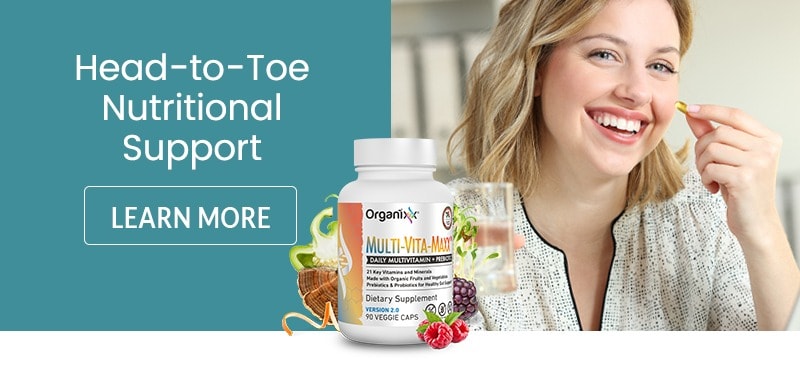
Do you wake up in the morning craving a few more Zs? Do you sometimes suffer from the “late afternoon blahs?” There are so many reasons why our energy sometimes tends to lag at key moments in the day: adrenal fatigue, lack of quality sleep, stress, or aspects of a more serious condition can all play a part. Instead of downing that second (or third) cup of coffee, however, why not get energized with essential oils instead? Here is a rundown of our “Top 5” essential oils for energy!
5 of the Best Essential Oils for Energy and Focus
Feeling sluggish? Try a drop or 2 of one of these essential oils!
#1. Peppermint
Peppermint (as well as spearmint) has the ability to uplift as well as energize. This is a perfect essential oil to use if you are suffering from mid-afternoon “brain fog” or are just feeling a little blah. It contains high levels of menthol and has been shown to fight chronic fatigue as well as improve concentration. It can also help with the fatigue caused by slow digestion or overeating.
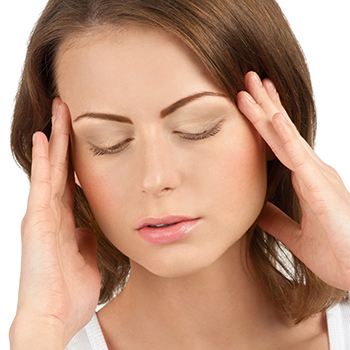
Try this: Rub a few drops of peppermint oil diluted in a carrier oil directly on your temples for instant refreshment! Be careful to keep it away from the eye area.
#2. Lemon
Lemon oil is right up there with peppermint as one of the most uplifting essential oils for focus and energy. In fact, all citrus oils, including grapefruit and orange, can make this claim. They are often used together as a supercharger in diffusers or applied topically (dilution is recommended) to boost energy and focus.
Citrus oils can elevate the mood and lift the spirits. All citrus oils, and especially lemon oil, contain healing antioxidant terpenes such as limonene. Lemon has also been associated with decreased blood pressure and can help support a healthy liver − leading to less toxicity and more overall energy for you!
Try this: You probably know that a tall glass of lemon water first thing in the morning can help hydrate and alkalize your body. But did you also know that you can replace that lemon slice with 1-2 drops of high-quality food-grade lemon essential oil and have the same effect? In fact, using lemon essential oil in your morning water can not only give you a lift for your day but can protect your teeth from enamel damage associated with the acid in lemon juice. Bottoms up!
#3. Eucalyptus
Eucalyptus oil is typically associated with help with respiratory healing but it can also stimulate the brain and improve energy levels. Eucalyptus contains cineole, a substance with documented healing qualities and over 1,000 research studies to its name! Eucalyptus has been shown to support the body when healing from many chronic diseases, including neurological conditions that can affect mood as well as energy levels.
Try this: Eucalyptus oil should never be used internally, but it can make a great diffuser oil if used in small amounts. Simply put a few drops on your diffuser filter and allow the refreshing menthol molecules in eucalyptus to uplift you and anyone who walks in the door.
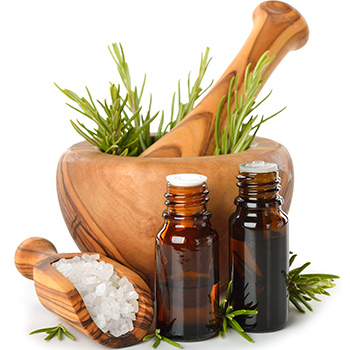
#4. Rosemary
First of all, rosemary is not just a super-antioxidant; it is a super super-antioxidant. According to the USDA, its ORAC antioxidant capacity is comparable to goji berries!
That fact alone makes it a super anti-inflammatory as well. Like eucalyptus, the effect it can have in supporting a healthy immune response can have profound effects on energy levels.
Studies such as those conducted at the University of Calgary have found direct biological and neurological connections between inflammatory diseases and fatigue responses. Rosemary has also been shown to help improve memory, balance hormone levels, and improve alertness as well.
Try this: Rosemary essential oil is an ideal oil to add to food, especially meats such as grass-fed chicken, for an extra savory experience. Just be sure it is top quality and food-grade rosemary essential oil. Always look for the “supplement information” label on any essential oil to know that it can be ingested.
#5. Frankincense
Frankincense is often called the “Holy Grail” of essential oils. Indeed, it was thought to be a holy substance in Biblical times. Today, the ways in which it can help you create balance and vitality in your life are too many to name here! Frankincense’s gift when it comes to lifting energy is in the way it can gently balance the nervous system. Its effect is not as instantly noticeable as peppermint or citrus, but it can be subtly long-lasting.
If you suffer from the lethargy and low energy that often comes with hormonal imbalance or depression, or if you sometimes have bouts of anxiety, then frankincense may just become your “go-to” essential oil. Studies have shown that the oil “massages” the limbic system and this can have an effect on soothing the nervous system overall.
Try this: Remember that a little goes a long way when it comes to frankincense. Rub it in diluted form on lymph node areas or use it in a diffuser for gentle invigoration. If you use a food-grade frankincense oil internally, one or two drops under the tongue should do the trick to soothe, balance, and uplift your mood. It’s interesting to note that frankincense is also one of the best essential oils for meditation and prayer.
How to Use Essential Oils
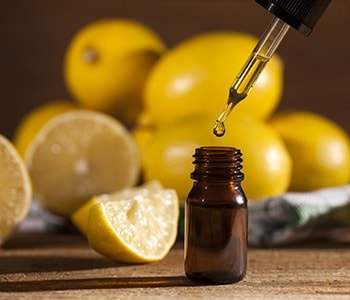 One of the amazing things about using essential oils for health and well-being is the diversity of options for using oils.
One of the amazing things about using essential oils for health and well-being is the diversity of options for using oils.
Whether you breathe in an oil through a diffuser or in a facial steam bath, apply it topically, or ingest a food-grade essential oil, the beauty of these oils is that their aromatic essence can enter into your system quickly.
Essential oils are comprised of very small particles that are able to break the blood-brain barrier, which is why people have found them so supportive for mental clarity and emotional well-being for centuries.
As a rule, less is more when it comes to how much to use, especially if you are using top-quality essential oils. Just 2-3 drops in a diffuser, on key areas of the body (mixed with a carrier oil), or under the tongue can do the trick. Also, try essential oils mixed with jojoba or another gentle massage oil for the ultimate relaxation and invigoration!
The powerhouse trio of herbs in Magi-Complexx Essential Oil provides the strongest, most synergistic healing effect, helping sufferers of arthritis pain, constant muscle aches and pains, neuropathy, systemic inflammation, slowed wound healing, circulatory challenges, as well as skin irritations like eczema, psoriasis, and acne.
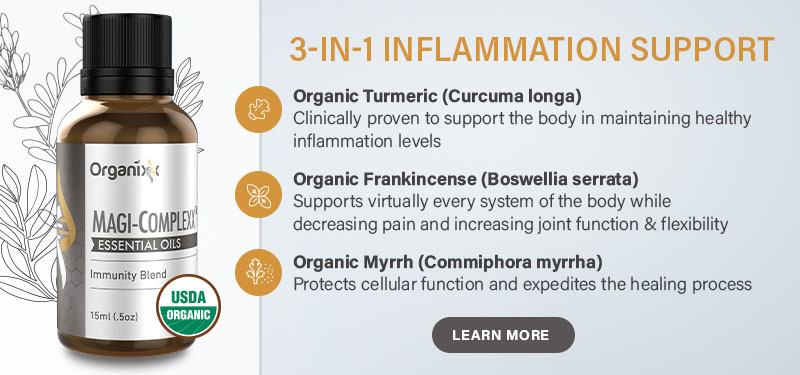
Quick Guide
- Frankincense Oil
- Lavender Essential Oil
- Clove Oil
- Grapefruit Essential Oil
- Orange Essential Oil
- Lemon Essential Oil
- Geranium Rose Essential Oil
- Peppermint Essential Oil
- Oregano Oil
- Rosemary Oil
- Eucalyptus Essential Oil
- Tea Tree Oil (aka Melaleuca)
There must be thousands of ways to use essential oils! These little bottles are packed with a myriad of potent phytochemicals (natural, plant-based compounds) that are powerful helpers − both for health improvement and also in and around the home. If you are an essential oil newbie, you won’t want to miss this article because we’re sharing 60+ great ways to use 12 basic essential oils. Even if you’re an experienced essential oil user, get ready to learn something new. It’s all about natural healing and improving the world we inhabit. Let’s dive in!
Frankincense Oil
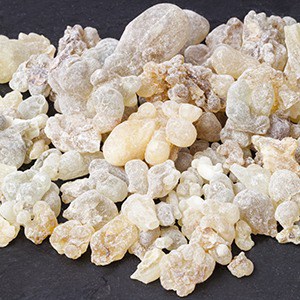 As a meditation aid. Use frankincense oil to help calm and center the mind, to promote spiritual awareness, and to cultivate a sense of inner peace while meditating. Frankincense contains compounds known as sesquiterpenes which work directly on the limbic system of the brain, the center of memory and emotions. Frankincense is calming, grounding, and centering to the nervous system. Diffuse it into your room, or just inhale directly from the bottle at the start of your meditation.
As a meditation aid. Use frankincense oil to help calm and center the mind, to promote spiritual awareness, and to cultivate a sense of inner peace while meditating. Frankincense contains compounds known as sesquiterpenes which work directly on the limbic system of the brain, the center of memory and emotions. Frankincense is calming, grounding, and centering to the nervous system. Diffuse it into your room, or just inhale directly from the bottle at the start of your meditation.- For respiratory support. Frankincense is a powerful health support for respiratory problems such as asthma, chronic obstructive pulmonary disease, pneumonia, and bronchitis. It even helps when suffering from laryngitis. Diffuse it into the room where you intend to spend some time. For best results, use an ultrasonic cool mist diffuser. Never heat essential oils, because heating them diminishes their therapeutic effects.
- To calm nightmares. Dilute frankincense oil as described below and rub over the large arteries along the sides of the neck before bed, to help relieve nightmares (yes, really!).
- Skin complaints. Whether your skin is dry and mature or oily and blotched with blemishes, frankincense oil has wonderful balancing qualities. It helps to reduce lines and wrinkles by tightening and toning skin, accelerates the healing of blemishes, skin ulcers and wounds, and stimulates cell regeneration. For anti-aging benefits, put several drops into your favorite night time moisturizer. For acne and blemishes, apply it neat directly on the problem area, unless you have very sensitive skin, then dilute as described below.
- For immune support. Breathe the vapor right out of the bottle, or diffuse frankincense oil to help boost immunity. Research shows that the natural plant chemical constituents in frankincense oil stimulate the immune system.1
Lavender Essential Oil
- Calming, stress relieving, sleep promoter. Feeling stressed out or having a night of insomnia? Dilute as described below, and rub lavender oil along the sides of the neck and/or breathe it in deeply to help you relax and sleep. You can also place a drop or two into a warm bath before you relax into it. Lavender has wonderful calming and soothing effects, and promotes deeper sleep.
- Stop the itch and burn of insect bites. Put a drop of lavender oil on a bee sting, mosquito, or other bug bite to stop pain, itching, and reduce swelling. Reapply as necessary. Lavender essential oil works really well for this, especially if applied immediately.
- Soothe burns and sunburns. Put two to three drops of lavender oil on a minor burn to help relieve the pain. Applied quickly enough, it should stop the burn from blistering as well. Keep a bottle of lavender oil in the kitchen for those burned fingers. Dilute it as described below and apply to sunburns to relieve pain and hasten healing time. Lavender oil is also wonderful mixed with a little organic Aloe vera gel and applied to the skin after sun exposure.
- Promising research for breast health. 2014 Iranian research published in the journal Nutrition and Cancer found that lavender oil kills breast cancer cells but leaves healthy cells unharmed. It’s important to note that this study was on cells in a petri dish, not on humans. The researchers concluded that: “L. angustifolia has cytotoxic and apoptotic effects in HeLa and MCF-7 cell lines, and apoptosis is proposed as the possible mechanism of action.”2
- As a flavor boost. Add a drop of high quality lavender oil suitable for consumption to brownie batter, chocolate icing, cookie dough, dessert recipes, raw chocolate, or even salad dressings. It’s absolutely delicious!
Clove Oil
- For toothache and
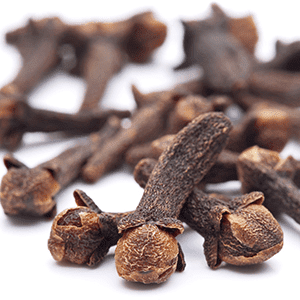 dental abscesses. Apply clove oil to a cotton swab and press it against the sore tooth and surrounding gums. Clove oil has great pain-relieving properties and has been used by the dental industry for years. Clove is often included in dental rinses and mouthwashes.
dental abscesses. Apply clove oil to a cotton swab and press it against the sore tooth and surrounding gums. Clove oil has great pain-relieving properties and has been used by the dental industry for years. Clove is often included in dental rinses and mouthwashes. - Potent antifungal. Multiple studies have shown that clove oil is a powerful antifungal, especially against Candida albicans.
- For cold sores. Clove oil has antiviral properties, especially against herpes simplex. Put a drop of clove oil on a cold sore to significantly decrease the pain and promote healing time. In fact, all of the essential oils in this article are good for this.
- For arthritic pain. Clove oil’s pain-numbing properties make it beneficial for rheumatism and arthritis. Dilute as described below and massage it into the affected area.
- Help kill bacteria in the kitchen & around the home. Clove is a natural antibacterial, powerful against many bacteria strains. It kills E. coli, Salmonella, Helicobacter pylori (implicated with stomach ulcers), Staphylococcus aureus (also known as golden staph), Streptococcus pneumoniae, and many others, with no observed side effects. Put a drop on your kitchen sponge, in dishwashing liquid, and on cutting boards to reduce bacteria naturally. Don’t forget telephones, toilet seats, doorknobs, and computer keyboards!
Grapefruit Essential Oil
- In your drinking water. A drop or two of grapefruit oil added to drinking water helps to boost metabolism, supports weight loss, and adds an immune boost with its high level of the phytochemical d-limonene. Grapefruit oil is also a potent antibacterial, and gives you a hit of vitamin C too!
- Ease a hangover. Grapefruit oil’s natural ability to stimulate the gall bladder and liver helps with detox after drinking alcohol. Diffuse it (see #2 above) or put a drop or two in your drinking water and keep sipping at it all day when in the throes of a hangover.
- In your vacuum cleaner. Put a few drops of grapefruit oil on a cotton pad and vacuum it up. The aroma will diffuse out into the room where you are cleaning and add a clean, fresh scent to the room. It also helps to kill airborne bacteria.
- Banish anxiety. Breathing in the invigorating vapor of grapefruit oil helps to ease feelings of anxiety, depression, and stress. It also helps to increase focus, so use it while studying or working on important projects. Diffuse it (see #2 above) or apply to a small area and wear it like a perfume.
- Help overcome sugar cravings. Breathe in grapefruit oil from the bottle just prior to eating, going to the coffee shop, doing the grocery shopping, or whenever you feel tempted to have sugar. It will help curb cravings for those not-so-good-for-you sweets.
Orange Essential Oil
- Cold and flu prevention. Put a drop or two of orange oil into your drinking water every day. Not only d
 oes it contain vitamin C, it also helps to boost the immune system. If you take extra vitamin C along with orange-infused water, it helps to increase absorption of the vitamin C.
oes it contain vitamin C, it also helps to boost the immune system. If you take extra vitamin C along with orange-infused water, it helps to increase absorption of the vitamin C. - Help heal mouth ulcers. Rub a drop of orange oil into the affected spot as frequently as you can remember to do it. It might sting a tiny bit, but mouth ulcers will heal much more quickly.
- Wound disinfectant. Drip orange oil directly into a wound after it has stopped bleeding, then cover with a bandage. Orange essential oil is an excellent antibacterial. It will also help speed the healing process due to its tissue regeneration properties.3
- Foot callus softener/remover. Rub several drops of orange oil into the affected area prior to putting on your socks and shoes.
- Skin anti-aging. Orange oil helps promote the production of collagen in the skin. It also helps the body detoxify, increases circulation, and improves skin tone and texture. Add a drop to skin care products such as toner and/or moisturizer to improve skin appearance and decrease the signs of aging.
Lemon Essential Oil
- In your cooking. Lemon oil is one of the most popular essential oils to cook with. Add a drop or two of lemon oil (or any citrus oil) to cake batter, muffin batter, seafood dishes, salad dressings, or any dish where lemon zest is required.
- For spot-free dishes. Add a drop of lemon oil to your automatic dishwasher soap. Run the cycle and enjoy spot-free dishes and a cleaner dishwasher.
- Add shelf life to fruit and vegetables. Fill a bowl or small bucket with cold water, add two drops of lemon oil and drench your fruit and/or vegetables in the water to preserve their shelf life. Best to do this before refrigerating.
- Diffuse lemon for health. Diffuse lemon oil (see #2 above) to help kill airborne bacteria. Research carried out by Dr. Jean Valnet (co-author of the book The Practice of Aromatherapy: A Classic Compendium of Plant Medicines and Their Healing Properties) shows that diffused lemon oil can rapidly kill off the bacteria that causes meningococcal infections, typhoid fever, staph infections, pneumonia, diphtheria, and tuberculosis.
- For oily hair. Lemon oil has a balancing effect on the oil glands of the scalp. Massage a drop or two of lemon oil into your scalp before you go to bed at night. Wash it out in the morning. Done over a period of weeks, you will notice much less oily hair. It will make your pillow smell nice and fresh too!
Geranium Rose Essential Oil
- For premenstrual tension and cramps. Massage geranium rose oil across the abdomen and lower back to help relieve cramps, muscle tension, and promote relaxation.
- For hemorrhoids. When painful hemorrhoids strike, add a drop of geranium rose oil to one teaspoon of organic coconut oil. Apply with a piece of gauze, leaving this in place if possible, and repeat several times a day or whenever particularly painful. Being a natural styptic, geranium rose acts by gently contracting blood vessels in the area.
- Repel ticks and dust mites. Before going outdoors, apply geranium rose oil on exposed areas of skin, around collars, cuffs, and pant legs. It also works well on pets, but make sure to heavily dilute for them. For dust mites, spray onto linens and put a drop on the dust cloth when dusting.
- For liver detoxing. Geranium rose oil helps to improve the flow of bile by dilating bile ducts, thus assisting liver detoxification processes. Dilute as described below and rub across the right side of the rib cage (over the liver).
- Skin healing and regeneration. Geranium rose oil is considered a natural antifungal, anti-inflammatory, antimicrobial, and antioxidant. Use it in skin tonics, lotions, moisturizers, and balms to aid with conditions such as dermatitis, eczema, psoriasis, oily skin, and acne. It also helps fade scars.
Peppermint Essential Oil
- Cool a hot flash. The high menthol content of peppermint makes it great for cooling off during
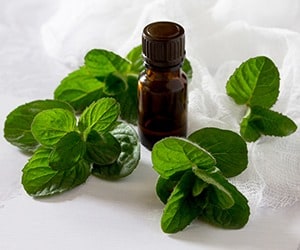 hot flashes. At the first sign of a hot flash developing, place a drop at the back of the neck, at the base of the skull, or on the collarbones. Breathe it in. This has an instant cooling and calming effect.
hot flashes. At the first sign of a hot flash developing, place a drop at the back of the neck, at the base of the skull, or on the collarbones. Breathe it in. This has an instant cooling and calming effect. - As a driving aid. Taking a long driving trip? Be sure to pack the peppermint essential oil. Its ability to wake up the nervous system and keep your brain alert is unmatched. It’s better than coffee and no caffeine jitters! Peppermint oil is also good for kids with ADHD. Add several drops of peppermint oil to a spray bottle containing distilled water, shake it, and spray it lightly on their clothes before studying to help increase concentration and clarity of thought.
- For aching muscles and joints. Peppermint oil can relax muscles which in turn helps relieve pain. Dilute as described below and rub into sore muscles and arthritic joints for some quick relief.
- For allergy relief. Peppermint oil not only relaxes skeletal muscles, it also helps to relax the muscles of the respiratory system. Inhaling the scent of peppermint helps to relieve congestion due to allergies and counteract the effects of pollen. Diffuse as described in #2 above.
- As a digestive aid. Peppermint oil is superb for helping to relieve indigestion and heartburn. Put just one drop of peppermint oil into a glass of water and drink. It works much more quickly than peppermint tea due to the concentrated nature of peppermint oil. If it’s too strong for you, just dilute it (see dilution instructions below) and rub it across the tummy.
Oregano Oil
- As an infection fighter. A 2016 research study found oregano oil to be effective against 59 different strains of bacteria, including multi-drug-resistant bacteria. It was even found to be effective against bacteria known to cause respiratory infections in cystic fibrosis patients.4 Oregano is also helpful when suffering from urinary tract infections. If taking oregano oil internally, please do so only under the guidance of a qualified aromatherapist and/or healthcare provider.
- As an anti-aging antioxidant. Oregano oil’s high antioxidant content makes it perfect for fighting the effects of aging, which is all about free radicals creating havoc throughout the body. If using it topically, be sure to dilute as described below because oregano can be a “hot” oil when applied to the skin. Always avoid the skin around the eyes and other sensitive areas.
- Ease a sore throat. Oregano oil will quickly relieve a sore throat. Add a drop to a glass of water and gargle with it. Sip it throughout the day. Oregano oil also helps to shorten the duration of colds and flu.
- For athlete’s foot and fungal infections. Dilute as described below and massage into feet, between toes, or into nails for an antifungal blast. Or get a basin of water and add a few drops of oregano and soak your feet in it. Oregano can also be used to help get rid of ringworm, another fungal skin infection.
- Eliminate intestinal worms. Oregano oil is a potent antiparasitic. Take it internally only under the care of a qualified aromatherapist or naturopath.
Rosemary Oil
- Anti-cancer, anti-proliferative. Turkish researchers in 2010 found that extracts fr
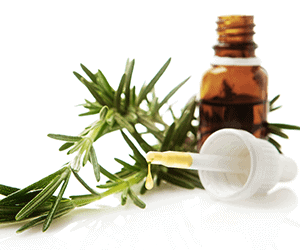 om rosemary had strong anti-cancer effects on several different human cancer cell lines. They concluded that “Rosemary extract is a potential candidate to be included in the anti-cancer diet with pre-determined doses avoiding toxicity.”5
om rosemary had strong anti-cancer effects on several different human cancer cell lines. They concluded that “Rosemary extract is a potential candidate to be included in the anti-cancer diet with pre-determined doses avoiding toxicity.”5 - Improve circulation, varicose veins. Rosemary oil helps to increase circulation. Warming and stimulating, rosemary oil assists the blood to move. This makes it extremely helpful for varicose veins and spider veins.
- Improve brain health. Rosemary oil is stimulatory to the central nervous system, and helps to promote clearer thinking. Rosemary has long been valued for its ability to help overcome mental fatigue, and to improve mental clarity and focus. Japanese researchers have recently shown that carnosic acid (one of rosemary’s phytochemicals) has neuroprotective functions in brain cells and may be helpful in the prevention of Alzheimer’s disease.6
- For healthy scalp and beautiful hair. Rosemary oil is beneficial for scalp problems like dandruff and seborrhea because it helps to regulate the secretion of oil in the scalp. It also aids hair regrowth. A 2015 study comparing rosemary with minoxidil, a commonly used drug for combating hair loss, found rosemary essential oil to be just as good as the minoxidil, but only after six months of use.7 So stick with it! Rosemary oil stimulates hair follicles, thus assisting hair to grow longer and stronger. It also promotes cell division and dilates blood vessels in the scalp, which stimulates hair follicles to produce new hair growth.
- Counteract the effects of stress. The uplifting aroma of rosemary essential oil helps to relax nerves and banish stress. A 2007 study on rosemary and lavender showed that this pair of oils decreases cortisol levels, the hormone released when one is under stress.8
Eucalyptus Essential Oil
- Strong insect repellent. Eucalyptus oil repels ticks, fleas, mosquitos, flies, and other annoying bugs. Eucalyptus trees have even been planted in many parts of the world to block the spread of mosquito-borne malaria. Eucalyptus can also be used to relieve the sting and itch of an insect bite.
- Fever reducer. Put a drop or two of eucalyptus oil on a damp, cool washcloth and rub it along the sides of the patient’s body, the chest, back of the neck, and bottoms of the feet to help reduce a fever.
- Improve blood flow to brain. Eucalyptus oil is known to be a vasodilator, meaning it dilates, or opens, blood vessels. In 1994, Austrian researchers discovered that eucalyptol, a phytochemical in eucalyptus oil (also known as 1,8-cineol), improved global blood flow to the brain after only 20 minutes of inhalation.9 A newer study released in 2016 by Korean researchers found that eucalyptol is also able to pass through the blood-brain barrier, a protective membrane that separates potentially harmful substances from harming delicate brain tissues. This research also found eucalyptol’s high antioxidant and anti-inflammatory properties to be helpful in the management of chronic conditions such as respiratory disease, cardiovascular disease, and degenerative nerve and brain diseases.10
- Assist upper respiratory infections and ease asthma attacks. Eucalyptus oil’s anti-inflammatory, antiseptic, and anti-phlegm properties work very quickly to open congested airways. Make a steam inhalation by boiling two cups of water, pour it into a large bowl, then let it cool for five minutes. Add a drop or two of eucalyptus oil. Then create a tent from a small towel draped over your head. Place your face over the bowl and carefully breathe in the vapor until you get some relief. This should only take a couple of minutes. This is great for bronchitis, head colds, chest colds, and asthma.
- Beneficial for people with diabetes. Some studies have shown that several different species of eucalyptus help to reduce blood sugar levels in mice.11 Also because eucalyptus is such an excellent vasodilator, the entire body benefits from this increase in blood circulation. Diabetics commonly lack good circulation, especially to their extremities, which is a dangerous situation and can result in limb amputation. To help combat this, dilute eucalyptus oil (as described below) and massage it into the legs, hands, and feet as needed.
Tea Tree Oil (aka Melaleuca)
- For eczema and psoriasis. Due to its potent anti-inflammatory benefits, tea t
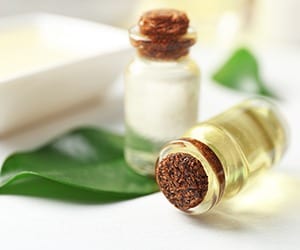 ree oil helps to relieve inflammatory skin conditions, especially eczema and psoriasis. Dilute as described below and apply to affected areas two to three times daily.
ree oil helps to relieve inflammatory skin conditions, especially eczema and psoriasis. Dilute as described below and apply to affected areas two to three times daily. - Boost your deodorant. If it’s an extra-hot day and your deodorant has failed, apply again, but this time with a drop or two of tea tree oil to help kill bacteria. Tea tree oil’s potent antibacterial properties are well proven with dozens of research studies.
- For pet health. Heavily dilute tea tree with coconut oil and, using a cotton swab, gently clean accumulated gunk in your pet’s ears. Proceed with extreme caution though and never drop essential oils into the ear canal (whether pet or human). Tea tree oil also helps to repel insects. Use a drop of tea tree oil on pet bedding or inside their crates to repel fleas and ticks.
- Prevent razor burn. Combine tea tree with a little coconut oil and apply after shaving to prevent or ease razor burn. If there are any blemishes or nicks or cuts on the skin, tea tree is a natural antiseptic.
- Natural insecticide, bug repellent, and bite reliever. Tea tree oil has long been used as a natural bug repellent by native Australian aboriginal people. Chinese research in 2016 found tea tree to be effective against the cereal weevil, Sitophilus zeamais.12 The cereal weevil is considered to be an extremely destructive pest to stored cereals all over the world. Tea tree also helps to relieve the pain, itching, and inflammation of insect bites.
How to Dilute Essential Oils
Although essential oils can be used neat (undiluted) in many cases, it is best (and more economical) to dilute essential oils before applying them to the body for personal care. Diluting also helps to prevent allergic reactions. Add small amounts (e.g., a drop or two) of your chosen oil to one-half to one teaspoonful of organic carrier oil such as coconut, almond, hemp, or jojoba.
If using with or around children or pets, use even less essential oil because their smaller bodies cannot tolerate an adult dose. Consult with a qualified aromatherapist or healthcare provider before using essential oils with pets or children.
A Final Word About Quality
Only use high-quality, organic essential oils that have been properly distilled so that their phytochemical content is not compromised. Look for bottles labeled as 100% pure essential oils and beware of cheap oils that may be diluted with potentially toxic chemical ingredients.
Finally, all of the above ideas for medical-related uses are for informational purposes only and do not constitute medical advice, diagnosis or treatment. Always consult with a qualified healthcare practitioner before using essential oils – especially if you are pregnant, nursing, or have an existing health condition.
The powerhouse trio of herbs in Magi-Complexx Essential Oil provides the strongest, most synergistic healing effect, helping sufferers of arthritis pain, constant muscle aches and pains, neuropathy, systemic inflammation, slowed wound healing, circulatory challenges, as well as skin irritations like eczema, psoriasis, and acne.

Why Milan Ditched Her Smartphone for a “DUMB” Phone 21 days…
No smartphone… No tablet… Could you do it? Find out why Milan, our Organixx freelance copywriter (and mom of four), decided to ditch her smartphone – for a basic flip phone – for a full three weeks…
Update #1: Struggles During Milan’s Smartphone Detox
Could you imagine surviving without a GPS? If you’re like us then you probably wouldn’t leave the house much… but for Milan, that’s life for the next few weeks! In this most recent update discover how a smartphone detox is making Milan realize how challenging this digital detox is and the unexpected emotions she’s experiencing.
Update #2: Milan’s FOMO (Fear of Missing Out)
Instagram, Facebook, Twitter, Snapchat. They all have the power to bring us together with the ones we love, but what happens when you can’t be where the fun is happening? The fear of missing out or “FOMO” can often be the cause of stress and anxiety. Discover how Milan is overcoming these feelings during her smartphone detox challenge.
Update #3: 5 Shocking Things That Happened When Milan Quit Using Her Smartphone
It takes only seconds to send a text over a smartphone, so discover how the lack of texting is annoying Milan and her family during her smartphone detox. Discover why Milan feels embarrassed to go out in public without her smartphone and what’s causing her latest insecurities.
Organixx Cleanse & Detoxx is a two-step formula that provides a gentle yet powerful full-body detox using organic botanical ingredients. Naturally purge your body of toxins, chemicals, free radicals, heavy metals, waste, as well as bacteria, and pesticides. Easily cleanse your colon, liver, kidneys, lungs, and lymphatic system resulting in increased energy, and better digestion with more nutrient absorption, in addition to improved immunity, mental clarity, and overall health and wellbeing.
